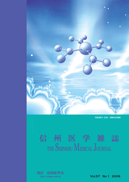Volume 62, Issue 4
Displaying 1-14 of 14 articles from this issue
- |<
- <
- 1
- >
- >|
Foreword
-
2014 Volume 62 Issue 4 Pages 225-226
Published: August 10, 2014
Released on J-STAGE: September 01, 2014
Download PDF (208K)
Review
-
2014 Volume 62 Issue 4 Pages 227-237
Published: August 10, 2014
Released on J-STAGE: September 01, 2014
Download PDF (787K)
Original
-
2014 Volume 62 Issue 4 Pages 239-244
Published: August 10, 2014
Released on J-STAGE: September 01, 2014
Download PDF (319K)
Short Communication
-
2014 Volume 62 Issue 4 Pages 245-247
Published: August 10, 2014
Released on J-STAGE: September 01, 2014
Download PDF (263K)
Current Topics
-
2014 Volume 62 Issue 4 Pages 249-252
Published: August 10, 2014
Released on J-STAGE: September 01, 2014
Download PDF (314K)
My Choice of Speciality
-
2014 Volume 62 Issue 4 Pages 253
Published: August 10, 2014
Released on J-STAGE: September 01, 2014
Download PDF (236K)
Book Review by Author
-
2014 Volume 62 Issue 4 Pages 254
Published: August 10, 2014
Released on J-STAGE: September 01, 2014
Download PDF (149K) -
2014 Volume 62 Issue 4 Pages 255
Published: August 10, 2014
Released on J-STAGE: September 01, 2014
Download PDF (145K)
What’s New? -The Latest from the Labs
-
2014 Volume 62 Issue 4 Pages 256
Published: August 10, 2014
Released on J-STAGE: September 01, 2014
Download PDF (225K) -
2014 Volume 62 Issue 4 Pages 257
Published: August 10, 2014
Released on J-STAGE: September 01, 2014
Download PDF (250K)
Abstract of Meetings
-
2014 Volume 62 Issue 4 Pages 259-264
Published: August 10, 2014
Released on J-STAGE: September 01, 2014
Download PDF (408K) -
2014 Volume 62 Issue 4 Pages 265-268
Published: August 10, 2014
Released on J-STAGE: September 01, 2014
Download PDF (329K) -
2014 Volume 62 Issue 4 Pages 269-270
Published: August 10, 2014
Released on J-STAGE: September 01, 2014
Download PDF (185K) -
2014 Volume 62 Issue 4 Pages 271-279
Published: August 10, 2014
Released on J-STAGE: September 01, 2014
Download PDF (498K)
- |<
- <
- 1
- >
- >|
